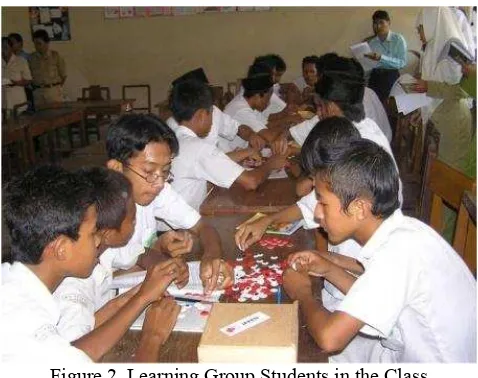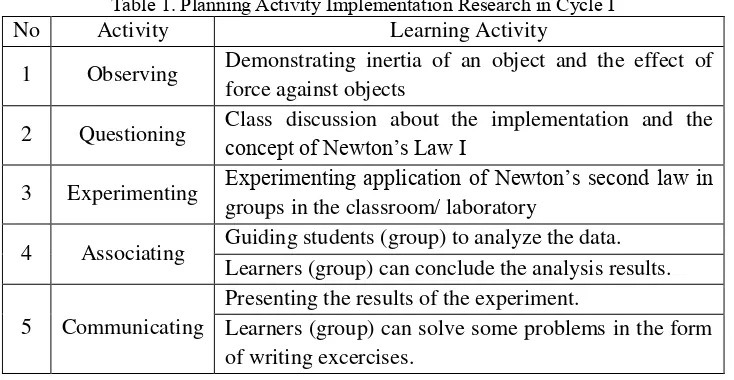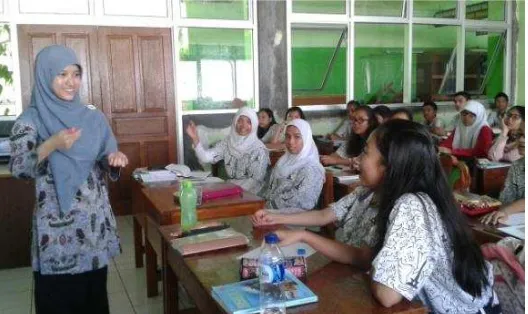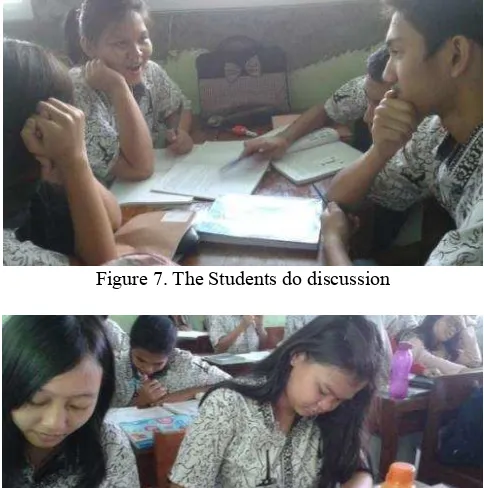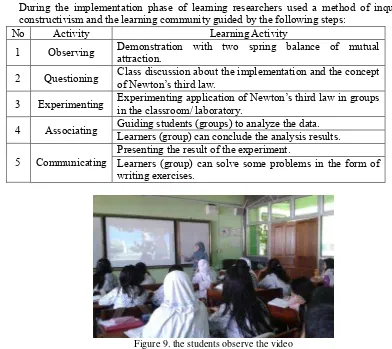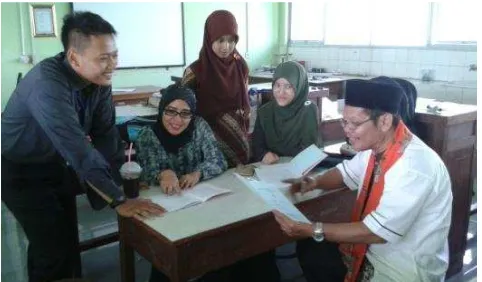EFFORTS TO IMPROVE THE STUDENTS LEARNING OUTCOMES AT
PARTICLE DYNAMIC TOPIC BY USING INQUIRY METHOD,
CONSTRUCTIVISM AND LEARNING COMMUNITY
IN CLASS X 5 SMAN 68 JAKARTA
Annisa Nor Fitria1, Hasan2, Vina Serevina3
1
University Student of Phsics Department (FMIPA) State University of Jakarta, 2Teacher of SMAN 68 Jakarta, 3Lecturer of Phsics Department (FMIPA). State University of Jakarta
[email protected], [email protected]
ABSTRACT
This study aimed to determine the improvement of student learning outcomes in learning physics using the methode of Inquiry, Constructivism and Learning Community. Constructivism method is a method of learning which is characterized by the activity of experimentation, questions, investigation, hypotheses, and models generated by the students themselves. Learning community methods can work if a group of people who are bound in learning activities, working together with others better than self study, interchange ideas and share experiences. The subjects were 36 students of class X Science 5 SMAN 68 Jakarta. The research method used is the method of class action in collaboration with teachers and lecturers. Action research by Kemmis & Taggart begins with stage: 1) Plan, 2) Act, 3) Observation, and 4) Reflection. The study was conducted in two cycles, Each cycle consisted of two meetings. Data collection methods with student learning outcomes, interviews and field notes, which is justified by data triangulation. In the first cycle, the result of learning outcomes of students reached 32.5% to the the minimum completeness criteria (KKM) with the score of Physics subject minimum 75. In the second cycle cycle of student learning outcomes reached 65.5%. The results of this study showed that by applying the learning methods: Inquiry, Constructivism and Learning Community can improve student learning outcomes.
Keywords: Learning Methods of Inquiry, Constructivism & Learnings Community improve Learning Outcomes.
BACKGROUND
The fact in field showed that the outcomes of students learning in physic is not yet satisfying. Based on the observation outcomes and student interview in class Science 5 SMAN 68 Jakarta got low outcomes and more than 65% student got under standardized score. Students considered the material is hard to be understood and applied in real life.
The low study outcomes was caused by the less effective of learning process. According to field view and interview outcomes with students, on learning of class X Science 1, X Science 2, X Science 3 teacher explained physics with PPT oriented, while X Science 4 and 5 teachers taught using speech methode so it’s boring. The teachers only taught the differential of formula and similar exercise. Another factor is the separation of formal knowledge of physic and student daily experience by teachers.
compentencies. In a room, a teacher was challenged to find right format and formulate in right strategies a learning design (Parman, 2005 : 9).
Contextual learning is a study concept which helps teachers to connect the lesson with students real life and boost students to connect the knowledge with their daily activities (Trianto, 2009 : 107). Contextual learning would work if the students apply and did what have been taught refer to real life problems which are related to role and responsibility of theirs as a family member, society, student, and worker (University of Washington, 2001). Student can build their own knowledge and experience which have been done by applying 7 components of Contextual Learning Model, i. e. constructivism, questioning, inquiry, learning community, modeling, reflection, and authentic assessment.
Contextual Learning Model makes students interested to the material taught and increase the study outcomes. By using Inquiry method, students will be independent with or without teachers guidance. This method focuses on student activity finding a learning concept with the ability owned. While constructivism method builds student understanding from new
experiences base on first knowledge. Learning should be a thing which be “constructing”
process not accepting knowledge, and learning community learning focuses on a process of study group, so it can expected that they can work in team better than self study, then sharing experiences and interchange ideas.
Based on the explanation above in order to achive what have been planned, teachers need to consider the effective strategy of learning. Thus this research was conducted about “The Effort of Increasing Student Learning Outcomes on Particle Dynamic Material Using Inquiry Learning Method, Constructivism, and Learning Community. The samples are Students Class 10 Science 5 in SMAN 68 Jakarta”.
Problem Formulation
Is the application of the method of inquiry, constructivism and learning community on the material of particles dynamic can improve student learning outcomes?
Research Objectives
To find out the application of inquiry methods, constructivism and learning community in improving student learning outcomes in class X science 5 in SMAN 68 Jakarta.
LITERATURE REVIEW The Fact of Outcomes Study
Social adjustment, all kinds of skills, ambitions, desires and expectations. It was agreed with the opinion of Oemar Hamalik (2002 : 45) who state that "the outcomes of study can be seen from the occurrence of a change of perception of behavior, including behavior improvement".
The result of learning is a learning process peaks. The results of the study occurred primarily due to teacher evaluations . Learning outcomes can be the impact of teaching and the impact of accompaniment. Both effects benefit to teachers and students (Dahar, R, Willis. 1996:90).
who get less than the limit score of KKM < 75, then the student did not pass the competency of learning and should make improvements score by way of remedial.
Based on the opinions of experts above, it can be concluded that the fact of the learning outcomes are the changes that occurred in the aftermath of a learning process. The change in question is a reflection of the knowledge, skills and attitudes acquired in following the learning process of students. Therefore, learning outcomes can be observed and measured through tests. The results of the study referred to in this study is the result of learning in physics conducted at SMAN 68 Jakarta with the KKM (Minimum Completeness Criteria) Physics in a score 75.
The Fact Inquiry Learning Method
According to Sumantri M. And Johar Permana (2000 : 142) is the way of presenting the lesson by giving the opportunity to students to find the information with or without the help of a teacher. Inquiry methods allow learners to find their own information that is necessary to achieve learning goals, because Inquiry method involves learners in mental processes for the discovery of a concept based on the information provided by the teacher.
Learning using method of inquiry has 5 components in common: Question, Student engangement, Cooperative Interaction, Performance Evaluation, and Variety of Resources (Garton, 2005).
Based on the opinions of experts on the a inquiry learning as a learning method that attempts to solve a problem through the steps systematically and logically.
Constructivism Learning Method
Karli constructivism Learning Method (2003:2) states constructivism is one view of the learning process which states that in the process of learning (acquiring knowledge) begins with the cognitive conflict that can only be overcame through self-knowledge and knowledge at the end of the learning process will be built by a child through the experience of the results of interactions with the environment.
According Suparno (1997:49) outlines the principles of constructivism taken are (1) the knowledge constructed by the students themselves, both personally and socially, (2) knowledge is not transferred from teachers to students, unless the student activity itself to reasoning, (3) students actively construct a continuous basis, resulting in a change of a concept to concept which is more detailed, complete, and in accordance with scientific concepts, (4) the teacher provide tools and good situation in order to run construction of students smoothly.
Based on the opinions of experts on the above, it can be concluded that the nature of constructivism learning method is a method of learning that is more about problem solving, develop concepts, and construction solutions rather than memorize algorithms and procedures used to obtain the correct answer. Learning is more characterized by the activity of experimentation, the questions, investigations, hypotheses, and
models generated by the
students themselves.
Community Learning Method.
Figure 1. Teacher Apply Learning Community Method
With a constructivist approach, teachers implement learning in study groups. students are divided into groups whose members are heterogeneous. Groups of students can vary widely in shape, both members and number. According to Slavin (1995 : 45) “effective group consisted of four to six people, with a heterogeneous group structure”.
Figure 2. Learning Group Students in the Class
Based on the opinions of experts in the above it can be concluded that the nature of the learning community learning methods can takes place when a group of people who are bound in learning activities, working together with others better than self study, exchange ideas and share experiences.
METHODS
This research was conducted at SMAN 68 Jakarta in class X Science 5 semester school year 2013/2014. SMAN 68 Jakarta is located on Jalan Raya 18 Jakarta Salemba Center.
cycle 1
1. Planning
At the planning stage of action, researchers make data collection instruments such as observation sheets, test the ability to think and student worksheets. Creating Learning Implementation Plan (RPP) in accordance with the method of inquiry, constructivism and learning community that will be presented in the learning process on the material of particle dynamics.
Figure 3. Creating Learning Implementation Plan (RPP)
2. Implementation
During the implementation phase of learning researchers used a method of inquiry, constructivism and the learning community with the following steps:
Table 1. Planning Activity Implementation Research in Cycle I
No Activity Learning Activity
1 Observing Demonstrating inertia of an object and the effect of force against objects
2 Questioning Class discussion about the implementation and the concept of Newton’s Law I
3 Experimenting Experimenting application of Newton’s second law in groups in the classroom/ laboratory
4 Associating Guiding students (group) to analyze the data. Learners (group) can conclude the analysis results.
5 Communicating
Presenting the results of the experiment.
Figure 4. The Implementation of Classroom Action Research
3. Observation
Observations were made collaboratively between the teacher, who is assisted by 3 colleagues, teachers and lecturers of UNJ is performed in conjunction with the implementation phase of the action. Photographed the events that occurred while performing cycles, and makes recording of data for field notes from interviews with the students for all the events that occur during the learning process. Observations are recorded in the observation sheet. (Data Secondary/ value students, event data and interview data).
Figure 5. Monitoring the activity of teaching and learning
4. Reflection
Figure 6. Reflection of Cycle I
cycle II
1. Planning
Planning cycle II is a reflection of the first cycle, at this stage teachers motivate students and debriefing activities to make students more active.
Figure 7. The Students do discussion
2. Implementation
During the implementation phase of learning researchers used a method of inquiry, constructivism and the learning community guided by the following steps:
No Activity Learning Activity
1 Observing Demonstration with two spring balance of mutual attraction.
2 Questioning Class discussion about the implementation and the concept of Newton’s third law.
3 Experimenting Experimenting application of Newton’s third law in groups in the classroom/ laboratory.
4 Associating Guiding students (groups) to analyze the data.Learners (group) can conclude the analysis results.
5 Communicating Presenting the result of the experiment.Learners (group) can solve some problems in the form of writing exercises.
Figure 9. the students observe the video
3. Observation
The observations made are still the same as the cycle I. Record all new findings that occur during the learning process. The data were collected to be processed and analyzed.
4. Reflection
Indicator of success has been achieved then the cycle is stopped.
RESULTS AND DISCUSSION
After the Class Action Research conducted by two cycles of the obtained data based on a triangulation of data, namely:
1) Data Events
2013/2014. SMAN 68 Jakarta.
Figure 10. Teaching and Learning Activity
In this research study results on the dynamics of the motion of matter particles tested with a test action to get students' learning outcomes. The experiment was conducted in two cycles that include both cycles performed reflection with a view to sharpen the action in order to obtain data that truly describe the success of the method. The acquisition of student learning outcomes as follows:
Table 3. Data Acquisition Student Results in Cycle I and Cycle II
.
Aspects of Assessment Cycle I Cycle II
Cognitive (Post Test) 32.5% 65.5%
Psychomotor
(Demonstration) 45% 75%
Afektif (scientific attitude
and students motivation) Assessment of the scientific attitude and motivation of students is not yet optimal.
Assessment of the scientific attitude improved significantly.
Figure 13. Chart of Students Learning Outcomes
2) Data Interview
This research was supported by the results of interviews with some objects such as student and teacher. The results of the interview as follows:
a. Three Respondents Teacher
There are three questions that I pose to 3 teachers are as follows: (1) agree Mr/Ms if the composition of the Teaching and Learning Activities more experimenting (doing experiments in the laboratory) from the theoretical (lectures in class)? The answer varies the teachers were among two teachers responded agree, because the application (lab) that stimulate the student to be active in understanding the theory worked and sharpening. While one teacher replied disagree, because the more physics to mathematical calculations that desperately need much time to explain. (2) According to Mr/ Ms, whether the use of instructional media can be good for student’s understanding of physics? All teachers answered yes. That instructional media so be good for student understanding. (3) Is the learning of physics that had Mr/ Ms taught to students already centered on activities students (research, project, etc.)? The majority of teachers said yes, already realized.
Figure 14. Interview with Physics Teacher of SMA Negeri 68 Jakarta 0
Chart of Students Learning Outcomes on Physics Learning
Cognitif (Post test)
b. Five Students respondent
There are three questions that I pose to 5 students as follows: (1) Do you think that with the help of instructional media can enhance the understanding of physics concepts? All the students said yes, that the media is very helpful in learning. (2) Does the teacher teach how to use a new method like this (inquiry, constructivism and the learning community) you feel happy and become increasingly understand the concept of such material? All students answered yes, they were very happy and become increasingly aware of the concept of the material. (3) you agree to be more creative in the future if the teacher in teaching, particularly in developing methods of learning a new one to avoid monotony and students do not get bored in learning? All students answered yes very agree. Creative teachers will generate smart generation.
Figure 15. Interview with Students of SMA Negeri 68 Jakarta
CONCLUSION
Implementation method of Inquiry, Constructivism and Learning Community in the Class X Science 5 SMAN 68 Jakarta, in general have increased student learning outcomes that have reached the KKM 75 achievements with percentages respectively in the first cycle (32.5%), second cycle (65.5% ). Then advised teachers to improve their teaching abilities and skills in guiding students. Teachers should be able and willing to use the strategies or methods and learning models in accordance with the subject or the subject matter.
REFERENCE
Dahar, Ratna Willis. 1996. Teori-Teori Belajar. Jakarta: Erlangga.
Dimyati dan Mudjiono. 2009. Belajar dan Pembelajaran. Jakarta: PT Rineka Cipta.
Hamalik, Oemar. 2002. Media Pendidikan. PT Citra Aditya Bakti. Bandung.
Karli, H. dan Yuliariatiningsih, M.S. 2003. Model-Model Pembelajaran. Bandung : Bina
Media Informasi.
Kasbolah, K. 1999. Penelitian Tindakan Kelas (PTK), Jakarta: Proyek Pendidikan Guru
Sekolah Dasar, Dirjen Dikti, Depdikbud.
Sadia, I.W. 1996. Pengembangan Model Belajar Konstruktivis Dalam Pembelajaran IPA di
SMP. Disertasi PPS UPI Bandung: Tidak Diterbitkan.
Slavin, R.E. 1995. Cooperative Learning. Second Edition. Boston: Allyn and Bacon
Sudjana, Nana. 2010. Penilaian Hasil Proses Belajar Mengajar. (Cet. XV). Bandung: PT.
Ramaja Rosdakarya.
Suprijono, Agus. 2011. Cooperatif Learning, Teori dan Aplikasi PAIKEM. (Cet. V).
Yogyakarta: Pustaka Pelajar.
Suparno, Paul. 2001. Filsafat Kontruktivisme Dalam Pendidikan. Yogyakarta: Kanisius.
Trianto. 2009. Mendesain Model Pembelajaran Inovatif-Progresif. Surabaya: Kencana Predana
Media Group.
University of Washington college of education. 2001. Training for Indonesian Education
Team in Contextual Teaching and Learning. State, Washington, USA.
Wina Sanjaya. 2006. Strategi Pembelajaran Berorientasi Standar Proses Pendidikan.Jakarta:
